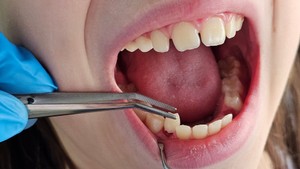Blog
As a parent, understanding the reasons your child may need a tooth extraction is crucial for maintaining their dental health.
As a parent, understanding the reasons your child may need a tooth extraction is crucial for maintaining their dental health. Although it might seem concerning, pediatric extractions are sometimes necessary to ensure proper development of your child’s mouth and to prevent future complications. This guide explores common reasons your child may need a tooth extraction, what to expect during the pediatric extraction procedure, and when it’s essential to consult a dentist. By being informed, you can make the best decisions for your child’s oral health and ensure a positive experience.
Understanding Pediatric Extractions
Pediatric extraction is a procedure that involves removing a tooth from its socket in the jawbone. The primary goal is to remove teeth that are severely decayed, damaged, or threaten a child’s overall dental health. Extractions may also be necessary to create space for orthodontic treatment, ensuring proper alignment of teeth.
It’s important to distinguish between primary (baby) teeth and permanent teeth when considering why a tooth needs to be extracted. Primary teeth, which typically erupt around six months, serve as placeholders for permanent teeth and are generally easier to extract due to their smaller roots. Conversely, permanent teeth, emerging later, are more firmly anchored and may require a more complex extraction process if damaged or impacted.
The extraction process usually starts with a thorough examination of the child’s mouth, followed by X-rays to assess whether a tooth needs to be extracted. If extraction is deemed necessary, local anesthesia is administered to ensure comfort and a pain-free procedure. The dentist will then carefully remove the tooth, minimizing trauma to surrounding tissues. Post-extraction, the dentist will provide care instructions to promote healing and recovery.
Common Reasons for Tooth Extractions in Children
There are several reasons your child may need a tooth extraction to safeguard their dental health and well-being. One common reason is severe tooth decay. Extensive decay can lead to infections and pain, potentially affecting adjacent teeth and overall oral health. In such cases, extraction may prevent further complications and pave the way for healthier teeth in the future.
Orthodontic needs are another critical factor in determining if a tooth needs to be extracted. As children grow, their mouths may become crowded, leading to misalignment. If excess teeth hinder proper alignment, pediatric extraction may be recommended as part of orthodontic treatment. This proactive approach helps create space for permanent teeth to emerge correctly, leading to a more successful orthodontic outcome.
Additionally, trauma or injury can result in damaged teeth requiring extraction. Accidents, sports injuries, or falls can compromise a tooth’s structure. If damage is irreparable, removing the tooth is essential to prevent infection and ensure dental health is not jeopardized. In these cases, timely extraction can facilitate future dental interventions, such as implants or braces, ensuring a bright and healthy smile.
What to Expect During a Tooth Extraction
Preparing your child for a tooth extraction can help reduce anxiety and ensure a smoother experience. Before the procedure, explain what will happen in simple terms, encouraging questions and providing reassurance about the care they will receive. Depending on the type of anesthesia used, it’s advisable to avoid feeding your child solid foods for a few hours before the appointment.
Regarding anesthesia, dentists typically offer local anesthesia to numb the area around the tooth. For anxious children, sedation may be recommended to help them relax. Your dentist will discuss the best option based on your child’s needs and the extraction’s complexity. Pain management is also a priority; your dentist may prescribe pain relief medication to ease discomfort following the extraction.
After the extraction, proper post-extraction care is crucial for recovery. Keep your child’s head elevated and encourage rest for the first 24 hours. Soft foods and plenty of fluids are recommended initially to aid healing. Avoid using straws, as sucking can dislodge the blood clot and lead to complications. Applying a cold compress can help if swelling occurs. Monitor the extraction site for signs of infection and keep follow-up appointments for optimal recovery.
When to Consult a Dentist
Recognizing signs that may indicate your child needs a tooth extraction is vital for their dental health. Common signs include persistent tooth pain, gum swelling, or difficulty chewing. If you notice these symptoms, consult a dentist promptly to prevent complications and ensure appropriate care.
Regular dental check-ups are essential for maintaining your child’s oral health. During these visits, your dentist can identify potential issues before they escalate, monitoring teeth and gums for overall development. Keeping routine appointments helps catch problems early, reducing the likelihood of needing a pediatric extraction.
Choosing the right time for an appointment can significantly impact your child’s comfort and health. If concerning symptoms arise, schedule an appointment as soon as possible. Maintaining a regular check-up schedule, ideally every six months, ensures teeth remain healthy and strong. By staying proactive, you can help safeguard your child’s smile and address any issues before they require extensive treatment.





